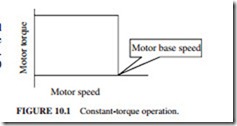BASIC PRINCIPLES OF AC VARIABLE-SPEED DRIVES
A variable-speed drive (VSD) is used to drive a motor at variable speed. The main parts of a VSD are
The control system of the VSD adjusts the output voltage and frequency so that the ratio of voltage to frequency remains constant at all times. The two modes of operation are as follows:
In this region, the motor increases in speed from zero to the rated base speed while the torque remains at the rated value (Fig. 10.1). The motor produces its maximum (rated) power at the base speed.
base speed (Fig. 10.2). The frequency of the VSD is increased and the flux is decreased while the armature voltage is kept at its rated value. Since the motor was at its maximum power at base speed, the torque must be reduced when the speed is increased (power torque X speed).
Related posts:
GLOSSARY of motor control term
BEARINGS AND LUBRICATION:STATISTICAL NATURE OF BEARING LIFE AND MATERIALS AND FINISH
Introduction to Troubleshooting
CLASSIFICATION OF DC MACHINES part1
Programming A Plc:Developing a Program
OBJECTIVE TEST On Armature reaction and commutation
MAINTENANCE OF MOTORS:CHARACTERISTICS OF MOTORS
Representation of Audio Signals:Elementary Logical Processes
The Compound Generator
Feedback Control Theory Continued:Important Features of Root Locus
Single-phase motors:Universal Motor
CONVENTIONAL D.C. MOTORS:D.C. MOTOR – STEADY-STATE CHARACTERISTICS
Fixed Appliance and Socket Circuits:Connections Units
Basic Concepts of Static Control part2

